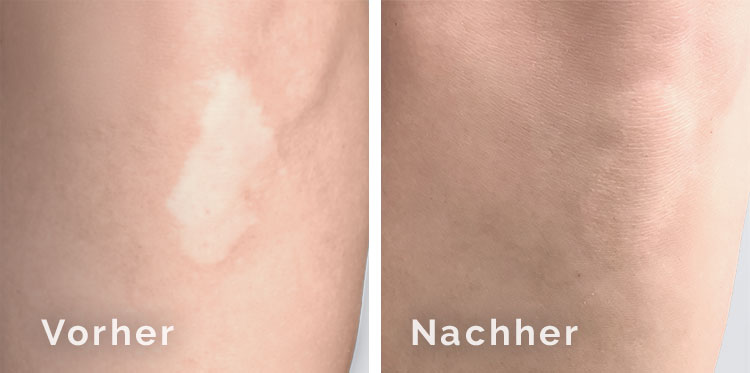
Vitiligo
Call me free of charge and without obligation
or send me an email and make an appointment for a consultation!
Frequent questions and answers:
Is the treatment painful?
The sensitivity to pain varies greatly from person to person and depends on age as well as skin type. As a rule, the sensitivity of the skin decreases with age. During their period, women can be more sensitive to pain. In the case of surgical scars, the nerve pathways are usually disturbed, so that there is no sensation at all in the region, i.e. no pain.
To make the treatment as comfortable as possible, an anesthetic ointment is used, which is applied about 30 minutes before the procedure.
How long does a treatment take?
This question cannot be answered in a general way, as the duration depends on the size of the area to be treated.
How many treatments are necessary?
Most surgical scars are treated in 3 needling sessions.
The interval between sessions is between 4-6 weeks.
If the result is still not satisfactory, the remaining areas can be color-matched using micropigmentation.
However, keep in mind that the pigmented areas do not tan with it. If you cannot do without sun, the color difference will become visible again in summer.
Skin pigmentation for white spot disease usually requires 2 sessions, possibly a third. The interval between sessions is between 4-6 weeks.
How long does the result last?
The improvements of scars by microneedling remain long-term.
The color pigments of a pigmentation last approx. 1-2 years, after which the color slowly fades.
It can take a few years for complete fading to occur.
Definitive time specifications in terms of how long the treatment will last are not possible.
This is influenced by many factors that are individual to each person. These include skin texture (dry or oily), metabolism, habits such as regular visits to saunas and solariums, extensive sunbathing or sweat-causing sports, and peelings.
To maintain a perfect color result, a touch-up is recommended after one year.
How much does the treatment cost?
The cost is calculated individually, depending on the size of the areas to be processed. Therefore, a price can be determined only after the consultation.
What should be considered before pigmentation?
You should be of legal age and healthy at the time of treatment and should not have consumed alcohol, drugs or stimulants. Coffee should be avoided 2 hours before the treatment.
Taking medications such as aspirin or other blood thinners should be avoided on the day of treatment.
If any of the following apply, please consult your doctor beforehand:
Are you HIV-infected, diabetic, hemophiliac, cancer patient or allergic? Do you use laser/chemical peels? Do you use a Retin A/peel treatment? Are you pregnant or currently breastfeeding? Do you use a pacemaker? Do you suffer from acute herpes simplex (cold sores), skin irritations/skin disorders, immune deficiency or autoimmune diseases?
What should be observed after pigmentation?
After the treatment, the treated area is bandaged with sterile gauze to protect it on your way home. Already in the evening you may remove the compresses and then it is best to wear loose, airy clothing without underwear.
Avoid water contact for the first 2-3 days. Use a shower patch or engage in “light zonal washing”.
As soon as healing has begun and a light scab forms, you have the option of using the original SwissColor care ointment Grazia. It supports the healing and makes the skin nice and soft.
For 1-2 weeks after the treatment you should avoid direct sun and solarium. Sauna, swimming pool or sweat-causing sports are also taboo.
